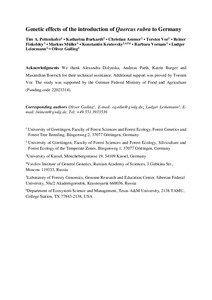Показать сокращенную информацию
Genetic diversity and differentiation of introduced red oak (Quercus rubra) in Germany in comparison with reference native North American populations.
| Автор | Tim A. Pettenkofer | |
| Автор | Katharina, Burkardt | |
| Автор | Christian, Ammer | |
| Автор | Torsten, Vor | |
| Автор | Reiner, Finkeldey | |
| Автор | Markus, Müller | |
| Автор | Konstantin, Krutovsky | |
| Автор | Barbara, Vornam | |
| Автор | Ludger, Leinemann | |
| Автор | Oliver, Gailing | |
| Дата внесения | 2020-01-20T08:01:49Z | |
| Дата, когда ресурс стал доступен | 2020-01-20T08:01:49Z | |
| Дата публикации | 2019-04 | |
| Библиографическое описание | Tim A. Pettenkofer. Genetic diversity and differentiation of introduced red oak (Quercus rubra) in Germany in comparison with reference native North American populations. [Текст] / Tim A. Pettenkofer, Burkardt Katharina, Ammer Christian, Vor Torsten, Finkeldey Reiner, Müller Markus, Krutovsky Konstantin, Vornam Barbara, Leinemann Ludger, Gailing Oliver // European Journal of Forest Research. — 2019. — Т. 138 (№ 2). — С. 275-285 | |
| ISSN | 16124669 | |
| URI (для ссылок/цитирований) | https://link.springer.com/article/10.1007%2Fs10342-019-01167-5 | |
| URI (для ссылок/цитирований) | https://elib.sfu-kras.ru/handle/2311/129600 | |
| Аннотация | Northern red oak (Quercus rubra) was introduced to Europe in the late 17th century and is today the most important deciduous foreign tree species in Germany. Despite its importance little is known about the origin of local red oak stands and patterns of genetic variation in German red oak stands. To be able to make recommendations regarding the adaptive potential of red oak and the selection of provenances with respect to climate change, a better understanding of the genetic diversity and structure of German red oak stands is needed. Therefore, individuals from 62 stands in Germany and North America were genotyped at five chloroplast microsatellite loci to characterize chloroplast haplotype diversity and geographical structure. Compared to reference stands from the natural distribution range, German stands demonstrated a relatively low genetic differentiation among populations and represented only a fraction of the haplotype diversity found in North America. For several stands located in the south of Germany a considerably higher haplotype diversity was found. Therefore, we conclude that German stands originated from a limited geographic range within the natural distribution, which was possibly located in the northern part of the native distribution range. While most German stands showed signatures of founder effects due to originating from a small number of individuals within a limited range, particularly stands in the south of Germany could have benefited from admixture and multiple introductions of different North American provenances. | |
| Тема | Chloroplast microsatellites | |
| Тема | Quercus rubra | |
| Тема | Haplotype diversity | |
| Тема | Origin | |
| Тема | Provenances | |
| Название | Genetic diversity and differentiation of introduced red oak (Quercus rubra) in Germany in comparison with reference native North American populations. | |
| Тип | Journal Article | |
| Тип | Journal Article Preprint | |
| Страницы | 275-285 | |
| ГРНТИ | 34.15.23 | |
| Дата обновления | 2020-01-20T08:01:49Z | |
| DOI | 10.1007/s10342-019-01167-5 | |
| Институт | Институт фундаментальной биологии и биотехнологии | |
| Подразделение | Базовая кафедра защиты и современных технологии мониторинга лесов | |
| Журнал | European Journal of Forest Research | |
| Квартиль журнала в Scopus | Q1 | |
| Квартиль журнала в Web of Science | Q1 |

